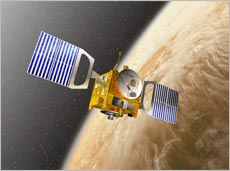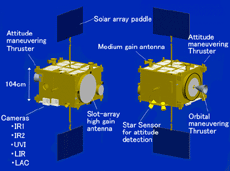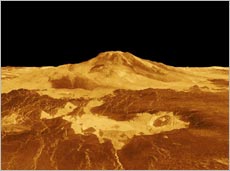Q. What kind of scientific instrumentation will PLANET-C be equipped with?
Five cameras will be on board to capture Venus in different wavelengths. When they take a photo of Venus every two hours, all cameras will be set to look in the same direction and image the atmosphere at different altitudes. This measurement sequence will allow us to have a moving image of the atmospheric circulation. By comparing the images taken by different cameras, we'll be able to study the atmospheric phenomena at different altitudes.
The IR1 camera is designed to image at approximately 1 μm in the infrared range. The camera will detect infrared radiation that's emitted from the surface and penetrates the clouds, in order to observe the lower atmosphere and its water vapor. IR1 will also look for evidence of active volcanoes. Although previous missions have discovered volcanic features covering the whole planet, live volcanic activity has not yet been found. If there is an active volcano spewing lava, IR1 will be able to detect the thermal emission. I'm keen to acquire evidence that Venus is alive.
The IR2 camera uses infrared waves at around 2 μm to study atmospheric circulation and carbon monoxide distribution in the lower clouds, at the 45 to 55 km altitude range. Earth clouds form when water vapor in the air is lifted by a rising convection current, and then cools down and condenses while expanding due to the decreased pressure. Cloud particles consist of droplets and ice crystals, but their size varies depending on the temperature at different altitudes, for example. Similarly, the particle size of Venus's sulfuric-acid clouds may vary depending on their location. We will use the two near-infrared cameras on board PLANET-C to investigate the size of the cloud particles.
The other three cameras are the Longwave Infrared Camera (LIR), the Ultraviolet Imager (UVI), and the Lightning and Airglow Camera (LAC). LIR will map the cloud-top temperature by detecting thermal emission in the altitude range of 45 to 70 km, at an infrared wavelength of 10 μm. The cloud-top temperature map will reflect the cloud height distribution, from which we can determine the horizontal cloud structure. The UVI will monitor sulfur gas at the cloud top in ultraviolet. And the LAC will measure the upper atmosphere and lightning flashes. On Earth, lightning is caused by static charges generated by the friction between cloud particles when the atmosphere is in violent vertical motion. If lightning occurs on Venus, it is a sign of major vertical atmospheric motions. Whether there is lightning on Venus has long been disputed. We'd like to settle this with PLANET-C.

PLANET-C orbit
Q. What is the key feature of the PLANET-C spacecraft?
The key feature is the spacecraft's orbit, which is designed to match the circulation of Venus's clouds. PLANET-C will monitor the planet horizontally from an elliptical equatorial orbit, so that its distance from Venus will vary from 300 km to 80,000 km. From the longer distance, the spacecraft will globally map Venus; from the shorter distance it will closely observe the atmosphere and the cloud dynamics. Within its 30-hour orbital period, PLANET-C is capable of monitoring cloud movement from directly above for 24 hours. The spacecraft takes one photo every two hours, and when the images are put together, you can see a time-lapse movie of the cloud motion - just like the clouds you see in TV weather forecasting. Having the same rotation period as Venus's super-rotation, which circles the planet in four days, PLANET-C will be able to closely observe the cloud motion of Venus for an extended period.
The key feature is the spacecraft's orbit, which is designed to match the circulation of Venus's clouds. PLANET-C will monitor the planet horizontally from an elliptical equatorial orbit, so that its distance from Venus will vary from 300 km to 80,000 km. From the longer distance, the spacecraft will globally map Venus; from the shorter distance it will closely observe the atmosphere and the cloud dynamics. Within its 30-hour orbital period, PLANET-C is capable of monitoring cloud movement from directly above for 24 hours. The spacecraft takes one photo every two hours, and when the images are put together, you can see a time-lapse movie of the cloud motion - just like the clouds you see in TV weather forecasting. Having the same rotation period as Venus's super-rotation, which circles the planet in four days, PLANET-C will be able to closely observe the cloud motion of Venus for an extended period.

Europe's Venus Express probe (Courtesy of ESA)

South Pole of Venus taken by Venus Express. The left half is the dayside, imaged at a wavelength of 380 nanometers. The right half, the nightside, was taken in infrared. You can see a swirling vortex of clouds. (Courtesy of ESA)
Q. How is the development schedule for PLANET-C progressing?
Starting in the summer, we've inspected the performance of all machinery, including an integration test for the prototype of PLANET-C. The development of on-board scientific instrumentation has involved many organizations, including the Institute of Space and Astronautical Science (ISAS), Hokkaido University, Tohoku University, the University of Tokyo, Osaka Prefecture University, the National Institute of Polar Research (NIPR), as well as many private sector businesses. We'll soon start building a flight model, and carry out various tests for about a year, starting in April 2009. Then PLANET-C will finally be launched by H-II rocket in 2010. Its arrival at Venus is scheduled six months after launch, and PLANET-C will carry out observations for two years. We're really looking forward to acquiring a lot of high-resolution images of Venus, and distributing them to the world. We'd like to release observation data as soon as possible.
Q. How much do you collaborate with scientists and space agencies overseas?
We are on very good terms with scientists in Europe and the United States. Our relationship with European scientists is especially close, as the European Space Agency's Venus Express is almost PLANET-C's sister probe. Since its arrival at Venus in April 2006, Venus Express has been accumulating a great volume of observation data, and its observations will continue until May 2009. Venus Express is also monitoring the Venusian atmosphere, but it is studying the chemical composition using spectrometers rather than cameras. Also unlike PLANET-C, Venus Express has a polar orbit.
When we started developing the PLANET-C mission in 2001, no other nations were interested in exploring Venus, because they were focusing on Mars and the Moon as places that are easier for human beings to land on. But, as soon as foreign space agencies heard about the PLANET-C mission, they began to take notice of Venus again. The Europeans were first out of the gate. They developed and launched Venus Express in a very short time, in November 2005, by reusing the parts and designs from Mars Express, which had already taken off. As for the United States, NASA has proposed a mission called Vesper (Latin for "Evening", as in "Evening Star") to study the Venusian atmosphere using a different method. All the space agencies develop and launch their missions independently, but there is no overlap among their objectives because each agency has chosen a different theme: Japan is looking at the mechanics of the Venusian atmosphere, Europe at its chemical composition, and the United States at its evolution.
We are all eager to see what the others find out, and we hope to enhance international collaboration by sharing observation data with other countries.

